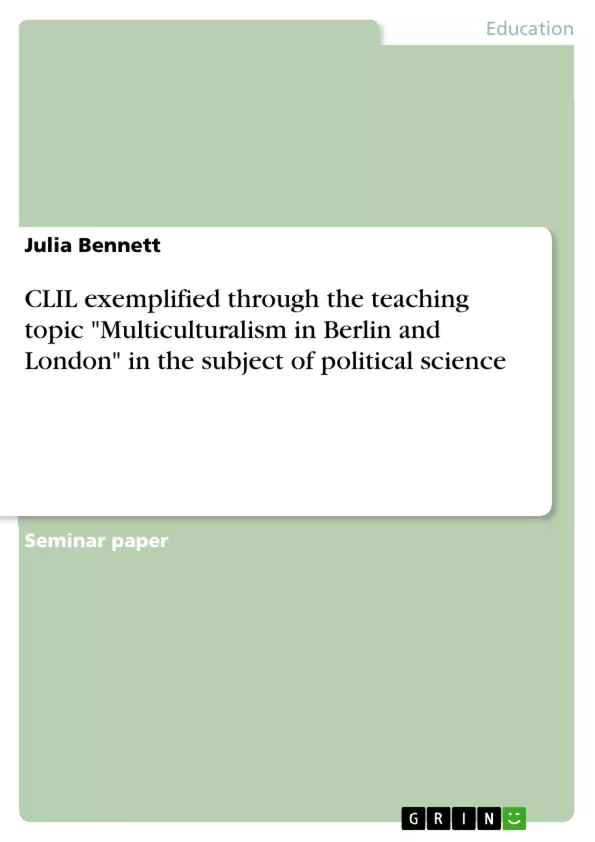1. Introduction
In this paper, I would like to clarify the importance of bilingual teaching as an innovative and
modern development in scholastic education. I would like to do so on using as an example of a
lesson I developed on “multiculturalism in Berlin and London” which could be subject matter for
a 9th grade political science class in Germany.
A requirement for the topic of this paper was to combine the two courses of module 5b ("An
Excursion to London," and "Introduction to Bilingual Teaching"), which I attended during
summer semester 2009 and winter semester of 2009/ 2010, with my content subject, political
science.
At the beginning of my work, I would like to define the term "Content and Language Integrated
Learning" (CLIL) and thus point out the inconsistency in the usage of this term. Furthermore, I
would like to focus on various justifications for bilingual teaching. In this context it is important
to examine and illustrate the importance, potential, and future prospects of CLIL. In addition, this
work demonstrates the objectives of bilingual teaching. The concept of bilingual teaching is
supported by the paradigm of Language Awareness which will be discussed in detail in this
paper.
Another focus of this work will be to put CLIL into a suitable context within the chosen topic of
multiculturalism in the European metropolises of London and Berlin. The broad term
“multiculturalism” will be defined in advance in this work in order to avoid misunderstandings.
Moreover, I will present some material for bilingual political science that I partly used as a
becoming teacher during my internship in a German High School in the city of Kassel. This
material mostly consists of empirical data about the ethnic population structure in London and
Berlin that should be analyzed and evaluated by the students.
Inhaltsverzeichnis (Table of Contents)
- Introduction
- Appeal for Content and Language Integrated Learning (CLIL)
- CLIL: A definition
- Reasons for supporting CLIL: A learning psychological and (subject-) didactical view
- CLIL: Objectives
- Language Awareness and multilingualism
- The topic ‘Multiculturalism’ in bilingual political science class
- Multiculturalism: A definition
- Ethnic population structure in Berlin, Germany
- Ethnic population structure in London, England
- Comparison of the Ethnic Population Structure of Berlin and London
- Conclusion
- References
Zielsetzung und Themenschwerpunkte (Objectives and Key Themes)
This paper aims to demonstrate the importance of bilingual teaching within scholar education using an example of a lesson on "multiculturalism in Berlin and London" suitable for a 9th-grade political science class in Germany. The paper integrates the author's experience from two courses on London and bilingual teaching, combining them with their expertise in political science. The work explores the definition and rationale for Content and Language Integrated Learning (CLIL), discussing its learning psychological and didactical benefits, and emphasizing the role of language awareness and multilingualism in CLIL. The paper further investigates the topic of multiculturalism in the context of CLIL, analyzing the ethnic population structures of Berlin and London. Finally, it touches upon the relevance of existing teaching materials for bilingual education in German schools.
- Definition and rationale of CLIL
- Learning psychological and didactical benefits of CLIL
- Language awareness and multilingualism in CLIL
- Multiculturalism in the context of CLIL, with an emphasis on Berlin and London
- Evaluation of existing teaching materials for bilingual education in Germany
Zusammenfassung der Kapitel (Chapter Summaries)
The paper begins by introducing the concept of bilingual teaching and its importance in modern education. It then delves into the concept of Content and Language Integrated Learning (CLIL), providing a definition, exploring its theoretical background, and examining its advantages from a learning psychological and didactical perspective. The author also emphasizes the role of language awareness and multilingualism in CLIL.
The paper subsequently moves on to discuss the topic of "Multiculturalism" in the context of a bilingual political science class, focusing on the ethnic population structure in Berlin and London. It aims to provide empirical material that can be integrated into a teaching unit on multiculturalism. The author examines the suitability of existing bilingual teaching materials used in German schools.
Schlüsselwörter (Keywords)
Content and Language Integrated Learning (CLIL), bilingual teaching, multiculturalism, language awareness, multilingualism, ethnic population structure, Berlin, London, teaching materials, didactics, learning psychology.
- Quote paper
- Julia Bennett (Author), 2010, CLIL exemplified through the teaching topic "Multiculturalism in Berlin and London" in the subject of political science, Munich, GRIN Verlag, https://www.grin.com/document/160134



